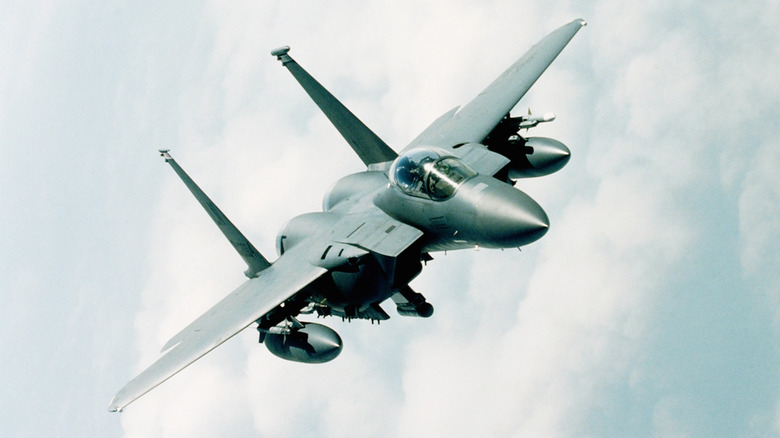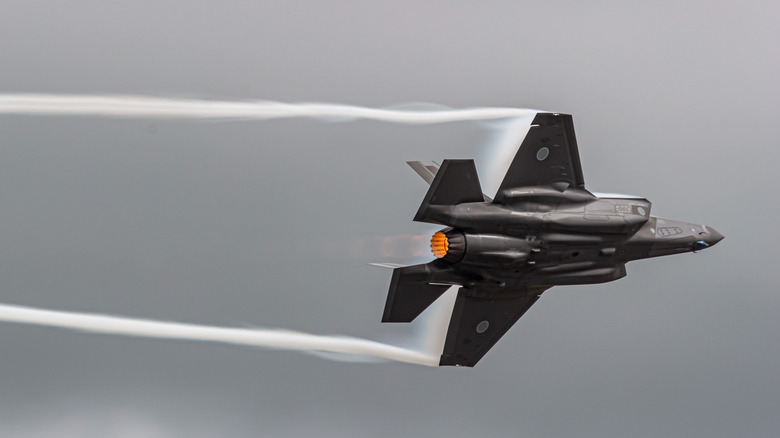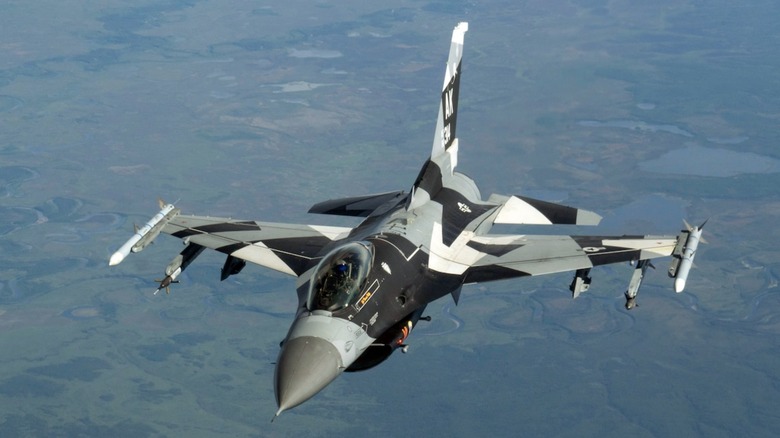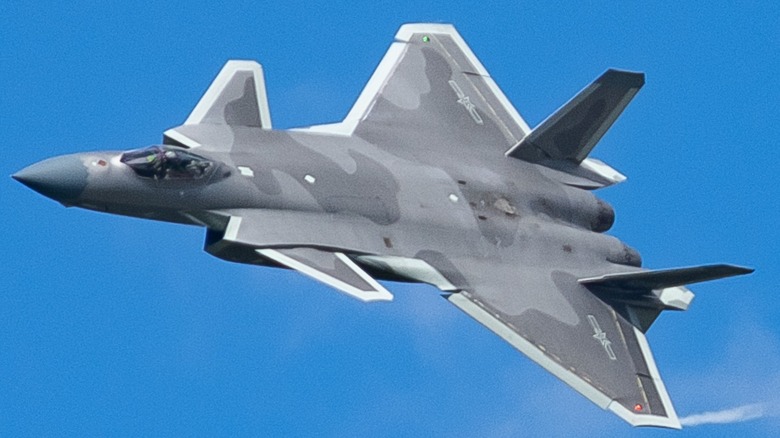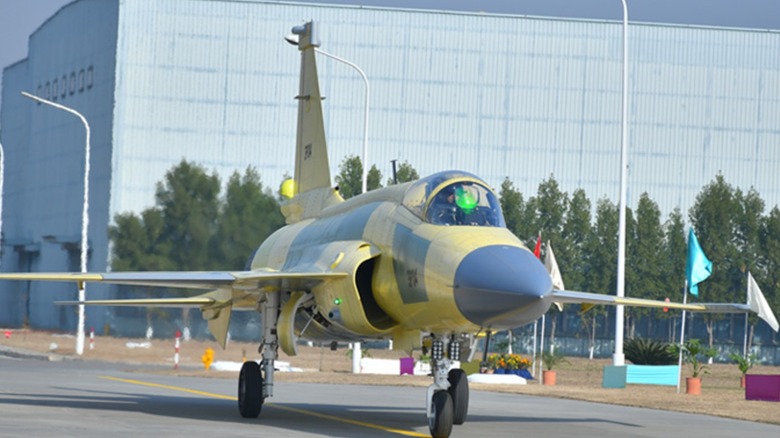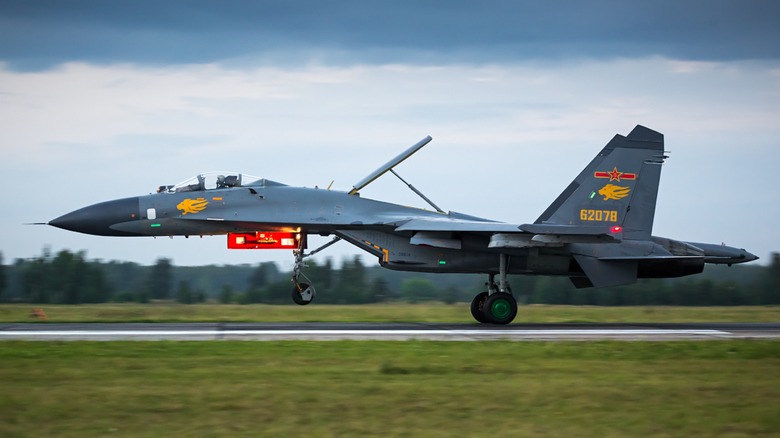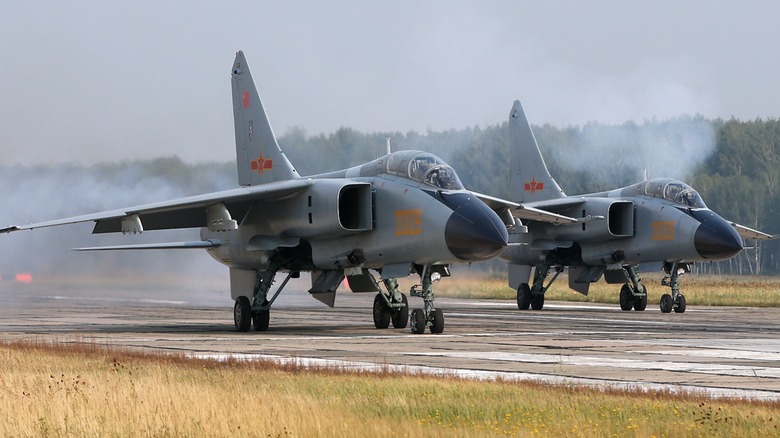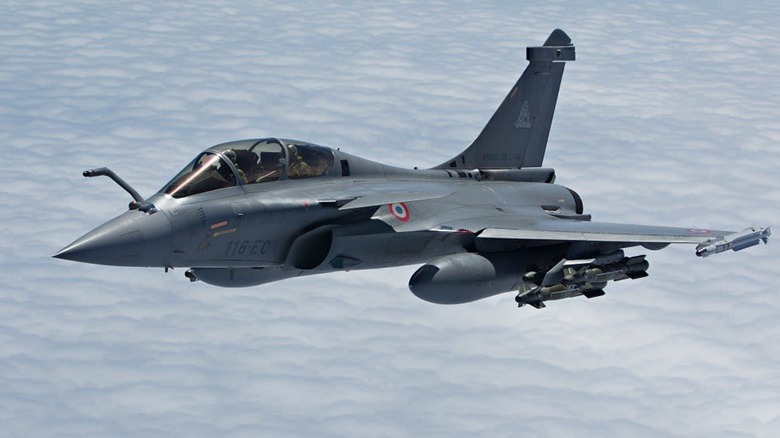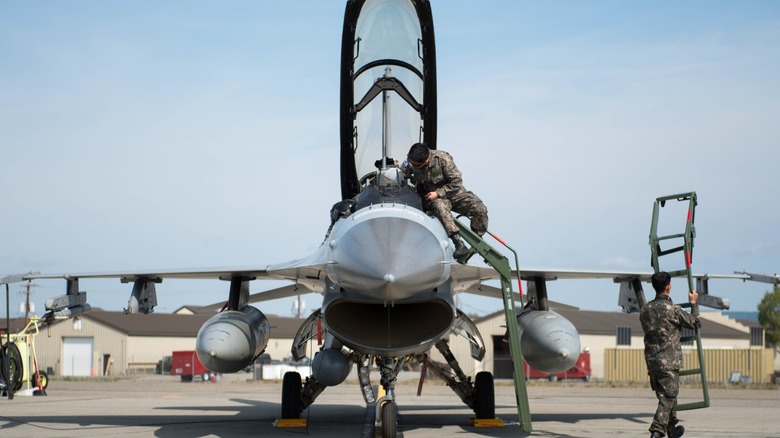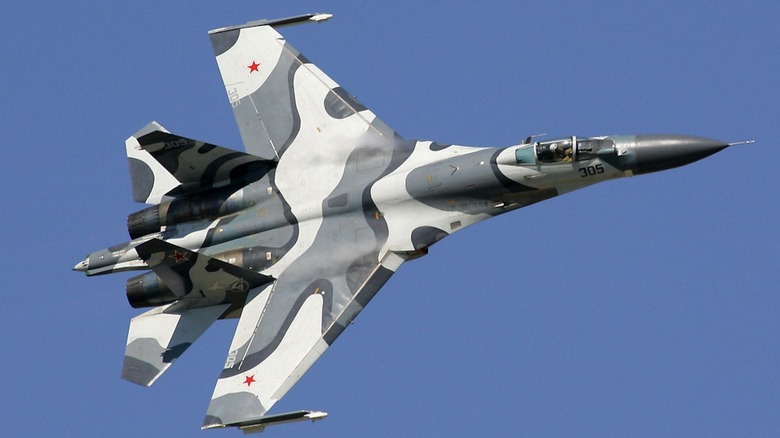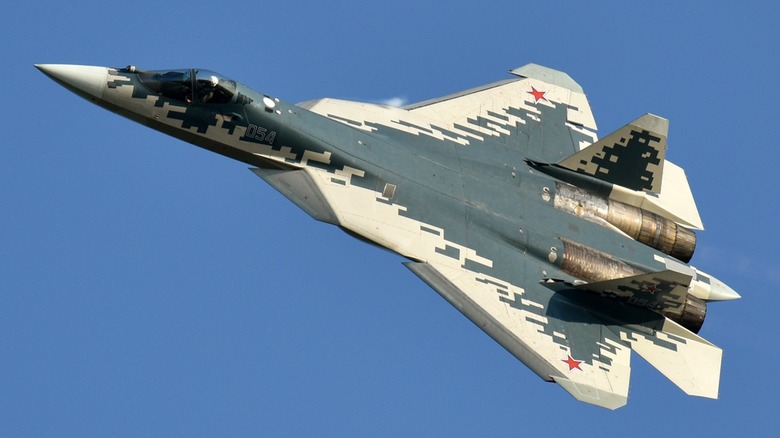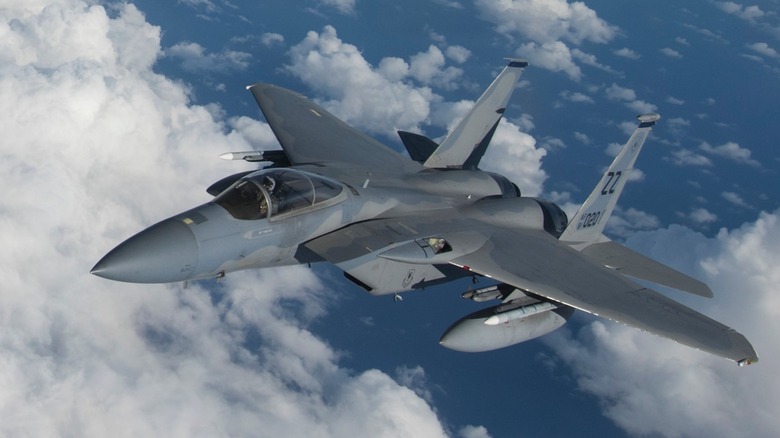10 Fighter Jets With The Longest Flight Range
Military planes have a wide variety of battlefield roles, and you can often determine a plane's role by looking at the letters in its designation or just by the aircraft's shape. These in turn define the vehicle's performance, equipment, and armament. While the world's militaries utilize countless types of planes, few are as synonymous with the word "military" as the fighter jet.
The National Museum of the U.S. Air Force defines fighter jets as "aircraft designed to intercept and destroy other aircraft and/or missiles," as well as vehicles capable of providing "interdiction and close air support." Fighter jets are intended to strike targets hard and fast — they are the Olympic sprinters of the aviation world. Extended engagements are possible, but not ideal because fighter jets don't have the tank capacity for long flights. However, some fighter jets can fly further than others.
Here are 10 fighter jets that can stay in the air the longest, at least as of the time of writing.
What Does Flight Range Mean?
When people talk about a jet's performance, they usually talk about its speed (which will crop up in this article). You can find plenty of information on the world's fastest jets and world's fastest fighter jets, but what does "flight range" mean? The answer is pretty simple.
According to NASA, a plane's range is calculated by multiplying its ground speed by its maximum flight time. Max flight time is determined by numerous factors, including the plane's fuel load, engine type, and throttle setting. Meanwhile, ground speed is exactly what it sounds like: the speed at which the plane travels above the ground. We need to know this stat, because the direction of the wind and how fast it's blowing affects a plane's speed. If two planes travel at the same "speed," the vehicle travelling with the wind will be pushed along and reach a higher ground speed, and the plane heading into the wind will fight against it and experience a slower ground speed.
One wrinkle in the calculation of "flight range" is the existence of tanker planes, which can refuel fighter jets without the need for landing. In an ideal world where you have unlimited fuel and don't have to maintain planes, these tankers could extend the flight range of a jet almost indefinitely. However, the "max flight time" calculation takes that into consideration and only includes a full tank of fuel in its calculation. Refuels don't extend the flight range, just soft reset the odometer.
Lockheed Martin F-16 Fighting Falcon
Lockheed Martin's' F-16 Fighting Falcon is arguably one of the most famous fighter jets in the sky. These planes have been in use for many years and exhibit plenty of strengths and weaknesses. The F-16 Fighting Falcon might not be as fast as planes like the F-15 Eagle and F-14 Tomcat, but it can stay aloft longer.
The United States Air Force has been using F-16s since 1976. The jets come in several models, such as the F-16A and the F-16B. The main difference between these versions is the number of seats — F-16As can seat one pilot, while the F-16B has room for two. While classified as fighter jets, the F-16 can fill a variety of roles. During Operation Desert Storm, F-16s frequently attacked airfields, military production facilities, and Scud missile sites.
According to official fact sheets, the F-16 Fighting Falcon's flight range is over 2,002 miles. For comparison, the contiguous United States is approximately 2,800 miles lengthwise. However, the Air Force uses the term "ferry range" in its data sheet, referring to the distance a plane can achieve with the maximum amount of fuel and minimal equipment, including cargo and passengers. A fully armed F-16 will not be able to achieve this range, especially once it starts speeding and banking across the sky.
Chengdu J-20 Black Eagle
You might expect some of a plane's performance metrics to come at the cost of others. For instance, a roomy fuel tank could negatively impact speed and take up space for ammunition, whereas a jet with powerful engines may not have enough room to hold a lot of fuel. China found a way to make a fighter jet that can travel at high speeds for longer than most of the competition.
China's J-20 Black Eagle is a stealth fighter jet that began service in September of 2017. Not only is the plane one of the fastest fighter jets in the world — eclipsed only by the F-22 Raptor and Dassault Mirage 2000 — but China can produce the J-20 faster than other countries can churn out their own military planes. It is widely believed that the J-20 Black Eagle is the result of reverse engineering a Lockheed Martin F117A Nighthawk that was shot down over Serbia in 1999.
The J-20 Black Eagle's operational range is calculated at 2,113 miles. At first glance, this seems like only a minor increase over the F-16 Fighting Falcon's range. However, the J-20 weighs almost twice as much, even without fuel or armaments. But on the other hand, the J-20 has a max speed of only 1,305 mph, compared to the F-16's 1,500 mph.
PAC JF-17 Thunder
When you think about Pakistan, the words "large air force" probably don't spring to mind. The nation's air force is downright miniscule. Pakistan might have more airplanes than, say, Moldova or Surinam, but it has nowhere near as many panes as the U.S. or China. However, the quantity of planes available rarely has any impact on their quality.
The JF-17 Thunder fighter jet is the product of a collaboration between the Pakistan Aeronautical Complex (PAC) and China's Chengdu Aircraft Corporation (CAC), the latter of which developed the previously mentioned J-20 Black Eagle. Pakistan started fielding the JF-17 in 2007, and while it is the backbone of Pakistan's air force, the jet is also employed in Myanmar, Nigeria, and Azerbaijan.
PAC's official website claims that the JF-17 Thunder has a ferry range of 1,880 nautical miles, which equates to around 2,163 miles. At around 17,560 pounds when emptied of weapons and fuel, the JF-17 is lighter than the F-16 and J-20, so it makes sense that this plane can fly farther. However, with a top speed of only 700 knots (around 806 mph), it flies at a snail's pace compared to other fighter jets.
Shenyang J-11 Flanker B
Many military planes are merely iterations of previously existing vehicles. It's not uncommon for allied nations to receive technology, including military jets, and make it their own. This practice was used to give China a fighter jet with a frightening flight range.
The Shenyang J-11 Flanker B+ is a fighter jet based on the Sukhoi Su-27 Flanker, one of the scariest Soviet jets from the Cold War. However, Chinese engineers and pilots didn't get their hands on the plane until 1992. Three years later, Russia gave China permission to produce its own Su-27 jets, specifically Su-27SK models with reinforced landing gears and a different radar. These planes became the J-11 fighter jets we know today.
While the Su-27 Flanker is arguably superior to the J-11 Flanker B+ (more on the Su-27 later), China's legal copycat is still a force to be reckoned with. The J-11 has an operational range of 2,193 miles and a top speed of 1,553 mph. Interestingly, the J-11 weighs almost as much as the Chengdu J-20 but outperforms it in terms of speed, range, and service ceiling (the highest the plane can safely fly and operate). While the Shenyang J-11 is built in China, most of its armaments hail from Russia.
Xi'an JH-7 Flounder / FBC-1 Flying Leopard
While fighter jets sit at the lower end of active combat vehicle flight range, bomber jets tend towards the opposite end. However, military planes designs can fit more than one battlefield role, which affects their performance. When you give a fighter jet bomber capabilities, you also give it extended flight range.
The Xi'an JH-7 Flounder is a combination fighter/bomber that can seat two people. While built in China, the plane relies on a British Rolls-Royce Spey turbofan engine. Interestingly, the JH-7 has two nicknames. The plane's official nickname is the "Flying Leopard," but NATO documentation adopted the label "Flounder" instead. Exported versions of the plane retain the "Flying Leopard" nickname but are relabeled as FBC-1.
According to reports, both the JH-7 and FBC-1 have the same capabilities. The plane's maximum operational range is 2,299 miles, and their speeds range from 727 mph to 1,118 mph depending on whether pilots are being economical with fuel or gunning it. Speaking of gunning, the JH-7/FBC-1 can carry up to 20,000 pounds of ammunition, including missiles, guided bombs, and standard drop bombs. Despite being able to carry out bombing duties, these planes are actually lighter than pure fighter jets like the Shenyang J-11 Flanker B+ and the Chengdu J-20 Black Eagle, which might explain the JH-7/FBC-1's flight range.
Dassault Rafale
Dassault Aviation is a French aerospace firm that specializes in private and military jets. The company is one of the few manufacturers that still produces trijet engine planes. On the defense product side of Dassault's offerings, the company also creates one of the world's most agile fighter jets, which also boasts an impressive flight range.
The Dassault Rafale is a twin-engine, delta wing fighter jet technically capable of filling more roles than just pure fighter. It can serve as a reconnaissance plane, an air defense jet, and even a refueling platform. Unlike other military planes, the Rafale is built out of composite materials instead of the standard aluminum and titanium construction, which makes it comparatively lightweight.
Currently, the Dassault Rafale's ferry range sits at an impressive 2,300 miles, but those stats aren't equivalent to other ferry ranges. According to the official Dassault website, the plane traveled that distance with three "drop tanks" (external auxiliary fuel tanks). When geared up for combat with two cruise missiles and combat and self-protection missiles (MICAs) — and three drop tanks — the Dassault Rafale's effective range drops to 1,150 miles. Still, the Rafale is one of the few fighter jets to ever outperform and "shoot down" an F-22 Raptor during training exercises, so we're not going to hold those drop tanks against it.
KAI KF-16 Fighting Falcon
While the F-16 Fighting Falcon is an iconic fighter jet, it leaves a bit to be desired. Sure, its flight speed is objectively superior to many planes on this list, but its flight range doesn't hold a candle to most of these jets. The opposite is true for the South Korean version.
In 1991, Korean Aerospace Industries (KAI) received a license to start producing its own F-16 fighter jets, specifically F-16 C/D planes. These vehicles would become what is known as the KAI KF-16 Fighting Falcon. Externally, these planes look more or less identical to the original F-16, but the internals are a completely different story. Every component from the engine to the radar jamming equipment is a step up from the F-16.
While the KF-16 Fighting Falcon's internal design is a straight upgrade over the original F-16, the same can't be said for overall performance. If you're looking at range, the KF-16 leaves the F-16 in the dust, as the South Korean variant can travel up to 2,610 miles, compared to the American original's 2,002 miles. However, when it comes to speed, the KF-16 can only manage a max of 870 mph, whereas the F-16 rockets past it at 1,500 mph. Still, the KF-16 is 1,000 pounds lighter than the F-16 but can carry around 9,000 pounds more of equipment, fuel, and ammo, which is a boon during missions.
Sukhoi Su-27 Flanker
We previously went over the Shenyang J-11 Flanker B+ and its impressive flight range. In that entry, we mentioned the fighter jet was based on the Sukhoi Su-27 Flanker. While the J-11 inherited long-range capabilities from the Sukhoi Su-27, the original boasts even more impressive stats.
The Su-27 Flanker was originally designed to rival American planes such as the McDonnell Douglas F-15 Eagle and Grumman F-14 Tomcat. Like the JH-7 Flounder, NATO provided the Su-27's nickname of "Flanker." While the Su-27 was intended to be an air superiority fighter, it was also built to work closely with Mikoyan MiG-29 Fulcrum jets. The Su-27 Flanker eventually became the basis for an entire family of fighters, including the Shenyang J-11 and other Su fighters.
Unlike most planes in this article, the Su-27 Flanker's range is up in the air, pun intended. According to military documents found in the OE Data Integration Network (ODIN) — a repository of military equipment around the world — the Su-27 has a range of approximately 2,193 miles. However, other sources put the fighter jet's max range closer to 2,734 miles. These latter sources also state that the Su-27 has an effective combat range of just under 746 miles.
Sukhoi Su-57 Felon
The Chengdu J-20 Black Eagle is not the world's only stealth fighter jet. It isn't even the only stealth fighter jet with a sizable flight range. Russia has plenty of its own, one of which is currently the country's most advanced fighter jet.
The Sukhoi Su-57 Felon is a remnant of the Soviet Union. The jet was envisioned as a means to modernize the country's air force and also work in stealth functionality. Development began in the 1980s and continued after the Soviet Union dissolved. When compared to Western planes such as the F-22 Raptor, the Su-57 isn't as stealthy or acrobatic, but it delivers superior air-to-ground attack capabilities and flying range.
Using the F-22 Raptor again as a measuring stick, that fighter jet has a ferry range of over 1,850 miles. Meanwhile, the Su-57 achieves a much more impressive 2,796 miles ferry range. When armed for combat, however, the fighter jet's range drops to 2,174 miles while traveling at subsonic speeds — 932 miles if it goes supersonic. Currently, it is believed that Russia has anywhere between four and 15 operational Su-57s, but Vladimir Putin plans to have that number grow by 76 before 2028. Whether or not that will happen remains to be seen, due to the fighter jet's slower-than-intended production rate and higher-than-intended costs.
McDonnell Douglas F-15 Eagle
Despite what its name implies, the F-16 Fighting Falcon isn't a successor to the F-15. These jets fill different niches within the Air Force. The F-16 is more affordable, whereas the F-15 can stay in the air longer than its rivals.
The McDonnell Douglas F-15 Eagle is an all-weather tactical fighter, first introduced in the 1970s. The plane has been through several iterations that changed the number of seats, among other things. The U.S. Air Force claims that the F-15 Eagle was responsible for 34 out of 37 air-to-air combat victories during Operation Desert Storm, and that the "E" model served the critical role of hunting down Scud missile launchers at night.
Throughout this article, each entry improved on a prior plane's range record by a few miles, maybe a few hundred miles at best, but when it comes to flight range, the McDonnell Douglas F-15 Eagle is the clear winner by literally a thousand miles. This fighter jet boasts a range of 3,450 miles. That's enough for the plane to launch from the northmost part of the contiguous United States, travel to the country's most southern point, pull a u-turn, and fly back to its launch runway. However, like the Dassault Rafale, this achievement isn't possible without some extra juicing. To achieve this ferry range, the F-15 requires three external fuel tanks and an unquantified number of conformal fuel tanks (additional tanks strapped closely to the plane).
